In May of 2020 my husband and I sold our house and moved into a brand new 5th-wheel toy hauler advertised as "4-Season". It was equipped with the "yeti package" that claimed to keep the RV systems protected and functioning even when the weather dropped to zero degrees Fahrenheit.
This sounded good to us because while our primary intention was to spend as much time in 70-degree weather as possible, we also knew that we'd spend most of November and December with our family in Colorado.
The first year after moving into our RV, Colorado was easy on us. We didn't get much snow and temperatures rarely dropped below freezing.
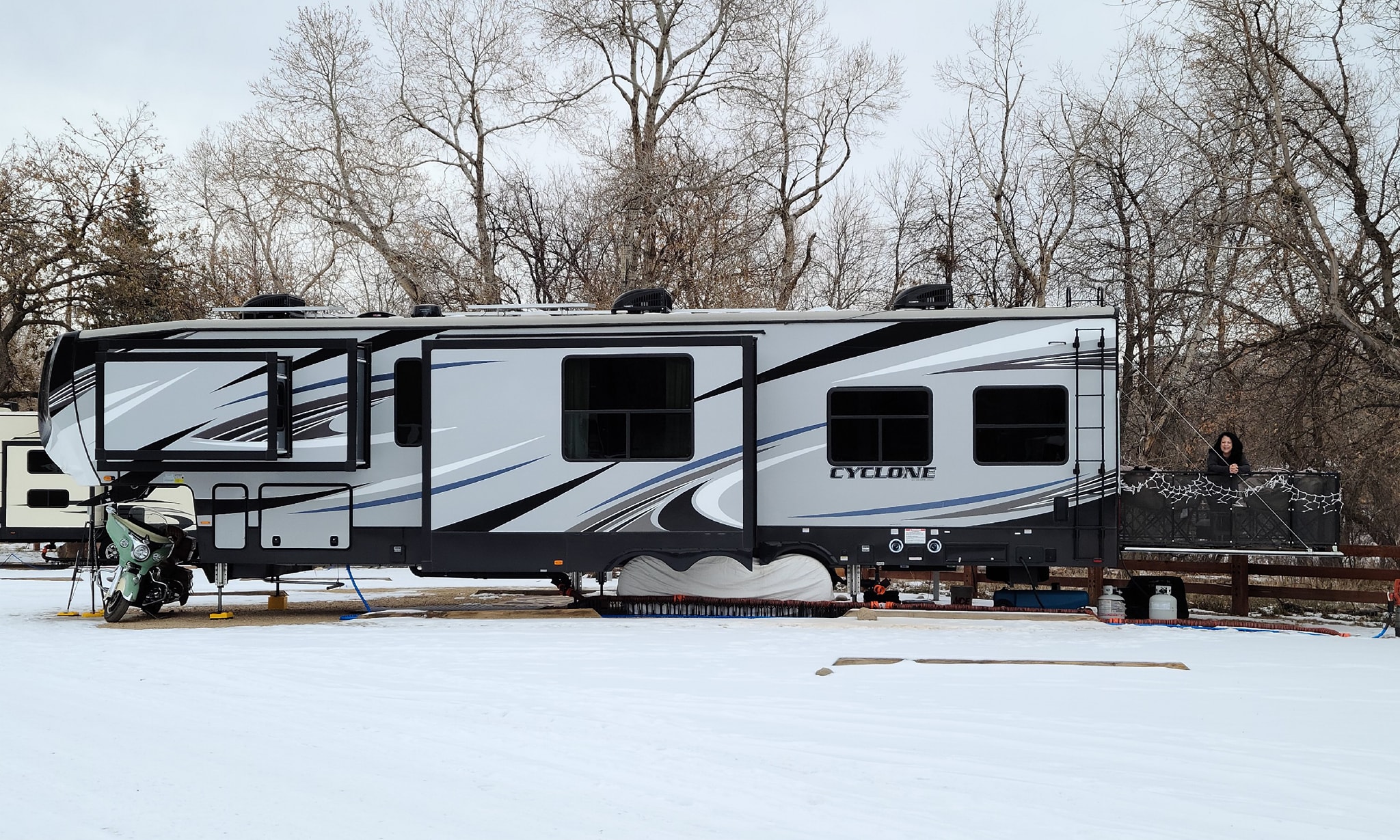

+ Subscribe to my newsletter for new and exclusive recipes in your in-box every month! As a full time traveler, living, working, cooking, and baking from a 5th wheel RV, it's also where I share our experiences of life on the road.
In 2021, a large snowstorm rolled in on the last day of the year, and temperatures dropped well below freezing and stayed there through the first week of January. We woke up every morning to frozen pipes, struggled to keep everything warm, and ended up with a broken black waste tank.
While parked in the Arizona desert later that year, we removed the bottom cover that runs the length of our RV, discovered that one of the heating pads on our tanks was not even connected and that the rest of yeti package "features" were woefully inadequate.
Steve repaired the damage to the tank and added some additional cold weather protection to our RV:
- He made sure all the tank heating pads were hooked up and in working order
- Insulated all the water lines by enclosing them in foam pipe insulation
- Inserted a thermostat-controlled heat cable into the foam pipe insulation, running the length of our water lines
All his work was put to the test later that year.
November and December of 2022 in Colorado were cold, snowy months. There was snow on the ground the entire 7 weeks we were there, nightly temperatures dropped well below freezing most nights, and daytime temperatures rarely rose above freezing. We even had a 3 day stretch in which temperatures didn't rise above zero degrees and dropped to a brutal -17.
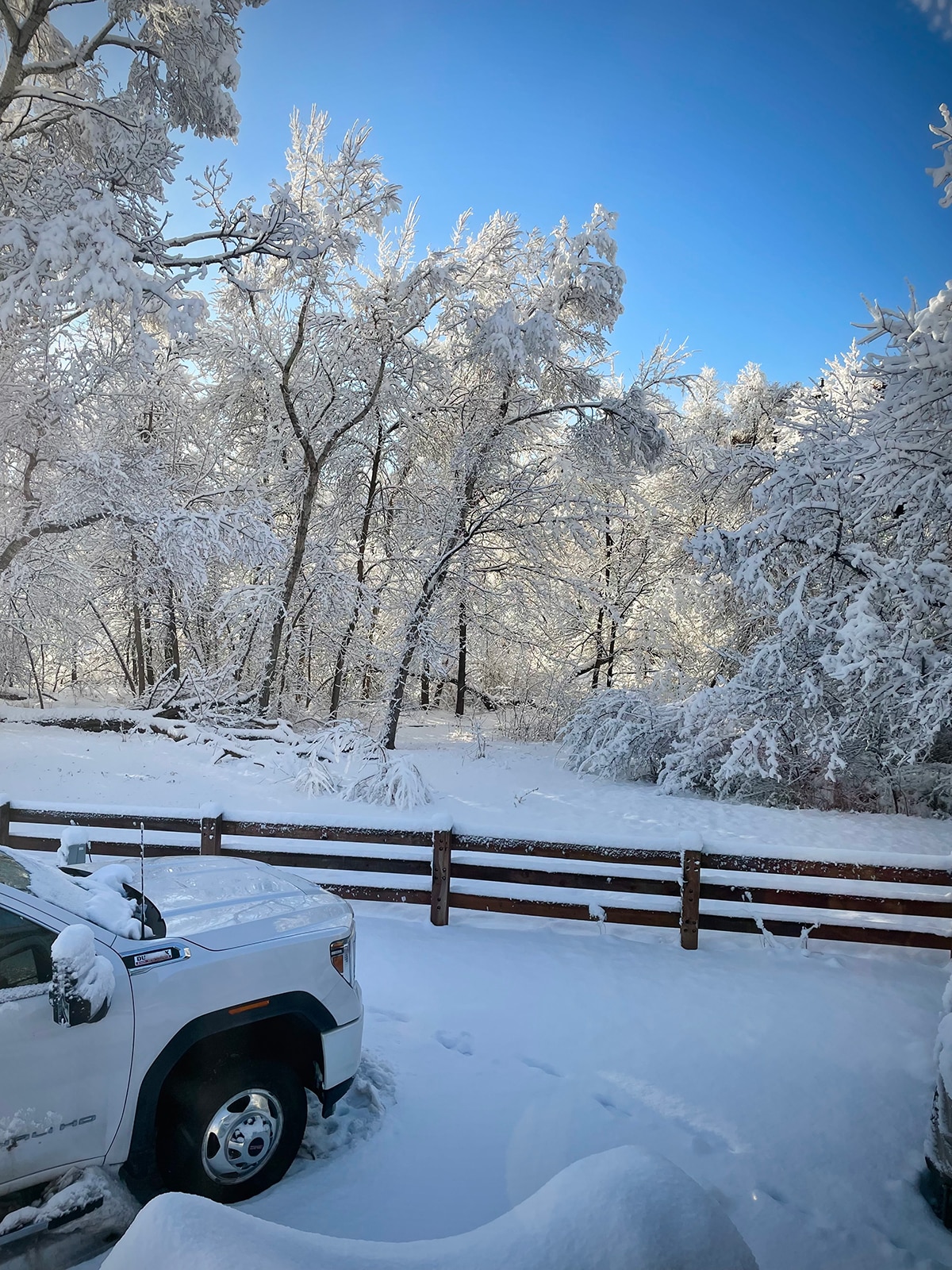
Staying warm and keeping everything functioning in an RV in sub-zero temperatures is a challenge.
Even RVs and campers with more effective cold weather protections aren't meant to withstand severe ice and snow and temperatures that stay well below freezing for days on end.
And yet, we emerged mostly unscathed. In addition to the work Steve did to properly insulate our freshwater and waste systems, we added additional cold-weather protections that kept us warm, our water running, our drains from freezing, and our batteries from cracking.
There are many reasons why RVers might spend time in cold, snowy places. Spending the holidays with family is our reason, but there are so many beautiful snowy places to visit in the winter months. If you're a skier, winter in Jackson Hole, WY, or the mountains of Colorado, Montana, or Utah might be reason enough.
Winter can be a beautiful time to get outside and explore new places and with some preparation there's no need to restrict yourself to places with warm and temperate temperatures.
Here's what we did to prepare and protect ourselves and our RV from the cold and snow plus some additional tips to help you prepare for RV winter camping.
Jump to:
3 Tips to Keep Your RV Plumbing System from Freezing and Bursting in the Winter
#1. Heat the "basement"
We refer to the storage compartments beneath the floor of our RV as the basement. That general area contains our batteries, most of the rig's wiring, the water lines, and connects to our waste tanks and fresh water tanks.
It's essential to heat this area if you want to avoid frozen pipes and cracked batteries. Many RVs use the propane heating system to keep this area warm. Ours doesn't work that way, so we added electric space heaters and thermostats to monitor the temperature in critical areas of these storage areas. And honestly, when the weather drops below zero, fortifying your heat situation is critical no matter what.
These extra measures worked great. Even when the temperature dropped well below zero, the storage compartments hovered around 40 degrees.
#2. A heated water hose and electric heat cables can keep the water running and drains from freezing
If you are camping in a place with fresh water hook-ups in the winter, a heated water hose is essential. Regular water hoses will freeze quickly in cold weather but a heated hose will keep the water flowing even when temperatures drop below zero.
We also wrapped electric heat cables around the sewer hose and every exposed pipe. In combination with the space heaters in the basement, the system worked pretty well.
If you DON'T have a heated water hose, but you DO have a heating pad on your fresh water tank, you can fill up your fresh water tank and disconnect your fresh water hose. But, in most cases, if you're going to do any winter camping in your RV, you'll want to invest in a heated water hose.
#3. Don’t leave the gray and black tanks open in freezing weather
Many RVers leave the gray tanks open when camping at parks with sewer hookups. But, in the winter, this can cause problems. Add some anti-freeze to black and grey waste tanks to prevent the wastewater from freezing and close them.
Empty the tanks when they are about ⅔ full. Even with anti-freeze in the tanks, it's important to not wait until they are completely full before emptying them. In extreme weather even tanks with anti-freeze can freeze and might cause damage if they are full.
2 Ways to Keep the Inside of Your RV Warm in Winter
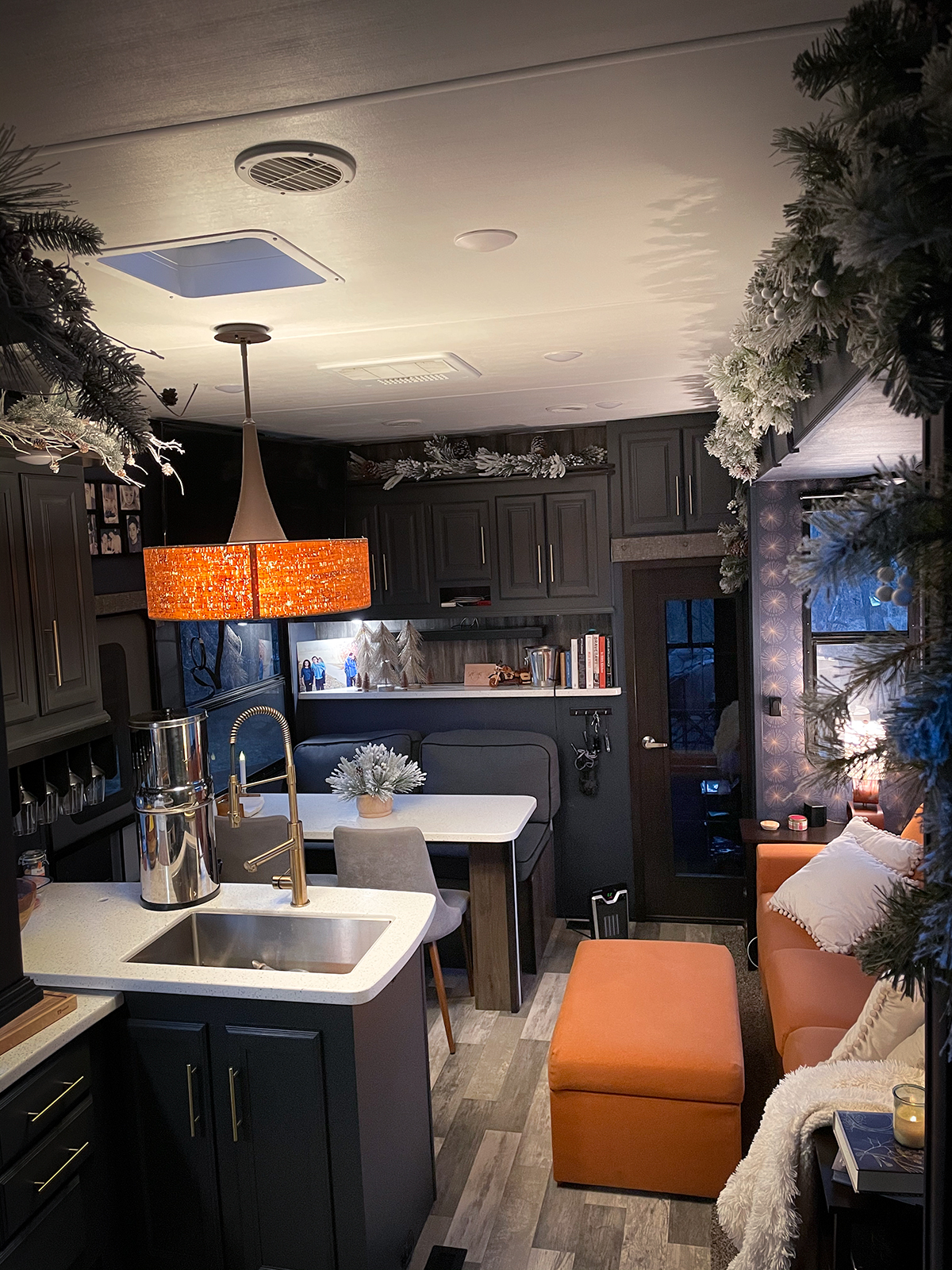
#1. Use electric heaters in addition to your RV's propane furnace.
To keep the temperature inside our RV at a safe and comfortable level in freezing weather, we kept 3 electric heaters plus an electric fireplace running non-stop.
Most of the time, this was sufficient to keep the inside of our RV warm on cold days. But, when the temperatures dropped below freezing, we also turned on our propane furnace.
Running this many electric heaters (3 space heaters plus the fireplace inside our RV plus two space heaters in the "basement" storage compartments) required some creative load management so that we could keep the load evenly distributed and not trip any breakers. It's important to understand your rig's electrical system and work within its limits.
#2. Insulate the windows
If your RV has double-pane windows, this might not be necessary. Our RV has single-pane windows that are not even approaching energy efficiency.
To add some additional insulation, we put clear shrink wrap over our windows which worked remarkably well. Two tips for using clear shrink wrap over RV windows:
- The tape sticks better to the walls around the windows than the window frames. As condensation builds up on and around the window frames, the tape will not hold.
- When possible, cover the windows when the temperature is above freezing. If you cover windows when the temperature is below freezing, the film will detach or tear from the inevitable expansion that happens when temperatures rise even slightly.
More RV Winter Camping Tips
- Protect your batteries. We use lithium-ion batteries in our RV. Below-freezing temperatures can cause lithium-ion batteries to crack and separate from surrounding materials, reducing their storage capacity. To protect our batteries against extreme cold, we put a thermostat-controlled electric space heater in the battery compartment.
- Remove Snow and Ice to Protect the Exterior of Your RV. When snow and ice are allowed to build up on the roof of an RV, it can open the seams in the roof as it thaws. This can create water leaks that cause structural and cosmetic damage.
Essential Equipment for Living in an RV in the Winter
- Shovel. Honestly, a shovel is important to keep on hand at all time in any size camper or RV no matter the weather.
- Electric space heaters. We generally use electric space heaters instead of our propane furnace to heat the inside of our RV when connected to shore power in the winter. When the weather is extremely cold, we use our electric heaters in addition to our propane furnace. If you're curious about the difference between forced air, ceramic, or catalytic heaters, this is a good comparison.
- Electric fireplace. Our 5th wheel came with an electric fireplace in the bedroom and it's all that's necessary to keep us warm on even the coldest nights. The one complaint we had about the fireplace is that it was not thermostat controlled. Earlier this year, Steve replaced it with an electric fireplace that IS temperature controlled and we are much happier with it.
- Heated hose. A heated water hose is essential if you want to keep your camper connected to city water during freezing weather.
- Electric Heat Cables. We wrapped heat cables around our sewer hose and every one of our RV's plumbing pipes.
- Foam Pipe Insulation. We enclosed our water lines with foam pipe insulation secured with zip ties.
- RV Skirting. If you’re staying in one location for a while during the winter months, installing an RV skirt is 100% worth the investment. An RV Skirt is material placed around the bottom of your RV to help insulate your tanks and pipes from cold, snow and ice.
- A Generator. Even if you're plugged into shore power, having a generator that can get you through power outages is essential.
- Tank Heating Pads. Heating RV waste water and fresh water tanks makes them much less likely to freeze. If your RV came with tank heating pads, make sure they are installed correctly. If you RV doesn't already have them, they are easy and inexpensive to install.
- Extra Propane. Running out of propane in the middle of a cold night is not a fun experience. Always make sure to have at least one extra full propane tank at the ready.
- RV Antifreeze. Adding antifreeze to black and grey waste tanks can help them from freezing in extreme temperatures even if you also have tank heating pads.
- Shrink Wrap Window Covers. If you have single pane windows, these clear shrink wrap window covers make a huge difference in insulating the inside of your RV from the cold.
- Electric Heating Blankets. We have two electric heating blankets in our RV and they are essential to keeping warm on really cold nights.
More RV and Camping Resources
- RV Living FAQs: Questions and answers about what it's like to live in an RV while traveling full-time and working remotely.
- Curious about where we're headed next and how we plan our itinerary? Click here for our yearly travel schedule
- Let's Get Lost is a Travel Journal about the places we've been, recommendations for things to do and see in those areas, and the reality of RV living and full-time travel.
- What is boondocking? Questions and answers about boondocking and dry camping.

+ Subscribe to my newsletter for new and exclusive recipes in your in-box every month! As a full time traveler, living, working, cooking, and baking from a 5th wheel RV, it's also where I share our experiences of life on the road.

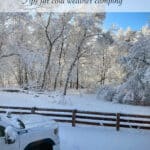
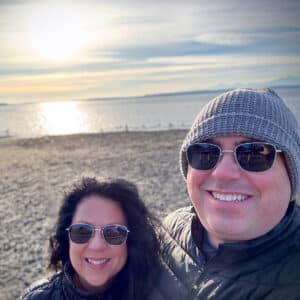

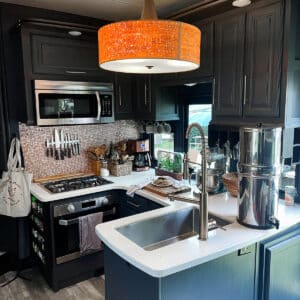

Comments
No Comments